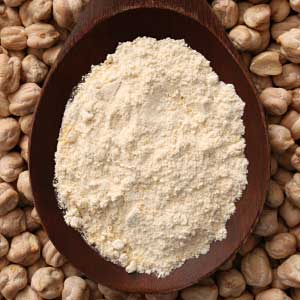Great ingredients make for great meals. Whenever you can, use the highest quality supplies for your recipes. The flavor difference will always come through in your finished dish.
If there is an ingredient that you are not familiar with, check our Ingredient section. There are pages and pages of information about the ingredients used in my recipes.
Garbanzo Beans (Chickpeas)

Chickpea Flour

Ingredient Information
Garbanzo Beans
Also called Chickpeas, these are small legumes a little larger than a pea. They are beige colored and have a creamy, nutty flavor. They are nearly perfect nutritionally, being high in carbohydrate and having modest amounts of protein and low in fat. They are low in saturated fat. A staple in Mediterranean and Middle Eastern cooking, they are sold dried or canned.
2 ounces dried garbanzos = 206 calories, 3g fat, <1g sat fat, <1g mono fat, 11g protein, 34g carbohydrates, 13mg sodium, 0mg cholesterol
See Also
Legumes
Bean Paste, Hot
Bean Paste, Red (Hot)
Beans, Black, Canned
Beans, Canned vs. Dried
Beans, Great Northern
Beans, Green
Bean Sprouts
Recipes Using Garbanzo Beans (Chickpeas)
Garbanzo and Feta Salad
Indian Chickpea Pancakes
Hummus
Chick Pea Salad
Tuna and Chickpea Salad | Coumadin
Safe Tuna and Chickpea Salad
Related Articles
Legumes in The Mediterranean
Diet
As with the wide variety of cabbages you can find in the
market, there are lots of different legumes (some of which you probably
didn't think were related to each other).
What are legumes, and
why are they good for you?
The word legume refers not only to the species of plants,
but also to any fruit that grows seeds lined up in a pod. (I find it interesting
that peas and black beans are actually considered to be fruit.) Also known
as Pulses, legumes include beans, soybeans, lentils, peas, peanuts, snap
beans and edible pods.
Slim Your Waist with Whole Grains
and Legumes
I've said for years that the most important factor in weight
loss is the number of calories you eat versus the number of calories you
burn. That said, we also know that some foods are more filling and satisfying
than others, which is just one explanation for why those who eat more
whole grains tend to gain less weight over the years. Further, those who
eat more legumes seem to have a lower Waist to Hip Ratio (WHR).
A Little More Fiber Can Help You
Reduce Your Risk of Diabetes
More and more children and adolescents are considered overweight
or even obese, leading to a related rise in the cases of insulin resistance,
pre-diabetes, and type 2 diabetes among children. This is usually attributed
to the amount of sugar in their diets combined with the poor quality carbohydrates
they eat.
